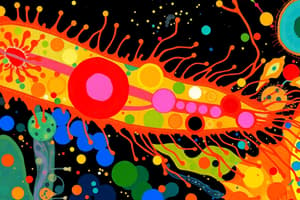Podcast
Questions and Answers
What is unique about the cell walls of diatoms?
What is unique about the cell walls of diatoms?
- They are embedded with silica (correct)
- They are made up of cellulose
- They are permeable
- They are made up of chitin
What is the term used to describe the accumulation of diatom cell walls over billions of years?
What is the term used to describe the accumulation of diatom cell walls over billions of years?
- Silica deposit
- Diatomaceous earth (correct)
- Diatom shell
- Diatom fossil
What is the primary mode of locomotion in protists?
What is the primary mode of locomotion in protists?
- Passive floating (correct)
- Cilia
- Muscles
- Flagella
What is the main characteristic of Mycoplasma?
What is the main characteristic of Mycoplasma?
What is the characteristic of Dinoflagellates?
What is the characteristic of Dinoflagellates?
What is the type of reproduction exhibited by protists?
What is the type of reproduction exhibited by protists?
What is the function of flagella or cilia in protists?
What is the function of flagella or cilia in protists?
What is the characteristic of the cell body of protists?
What is the characteristic of the cell body of protists?
What is the primary use of Diatomite, a soil formed from the fossilized remains of Diatoms?
What is the primary use of Diatomite, a soil formed from the fossilized remains of Diatoms?
What is the main characteristic of Diatoms in the oceans?
What is the main characteristic of Diatoms in the oceans?
What is the primary mode of nutrition for protozoans?
What is the primary mode of nutrition for protozoans?
What is the color of Dinoflagellates depending on the main pigments present in their cells?
What is the color of Dinoflagellates depending on the main pigments present in their cells?
What is the effect of toxins released by large numbers of red Dinoflagellates?
What is the effect of toxins released by large numbers of red Dinoflagellates?
Which of the following protozoans is an example of a flagellated protozoan?
Which of the following protozoans is an example of a flagellated protozoan?
What is the characteristic of the cell wall of Dinoflagellates?
What is the characteristic of the cell wall of Dinoflagellates?
What is the primary function of cilia in ciliated protozoans?
What is the primary function of cilia in ciliated protozoans?
What is the arrangement of flagella in Dinoflagellates?
What is the arrangement of flagella in Dinoflagellates?
Which of the following is NOT a characteristic of amoeboid protozoans?
Which of the following is NOT a characteristic of amoeboid protozoans?
What is the name of the disease caused by the parasitic protozoan Plasmodium?
What is the name of the disease caused by the parasitic protozoan Plasmodium?
What is the result of rapid multiplication of red Dinoflagellates?
What is the result of rapid multiplication of red Dinoflagellates?
What is the name of the example of red Dinoflagellates that undergo rapid multiplication?
What is the name of the example of red Dinoflagellates that undergo rapid multiplication?
Which of the following groups of protozoans includes organisms that have an infectious spore-like stage in their life cycle?
Which of the following groups of protozoans includes organisms that have an infectious spore-like stage in their life cycle?
Which of the following is an example of a ciliated protozoan?
Which of the following is an example of a ciliated protozoan?
What is the primary habitat for amoeboid protozoans?
What is the primary habitat for amoeboid protozoans?
Flashcards are hidden until you start studying
Study Notes
Kingdom Protista
- Single-celled eukaryotes, but boundaries are not well defined.
- Includes Chrysophytes, Dinoflagellates, Euglenoids, Slime moulds, and Protozoans.
- Members are primarily aquatic and form a link with other kingdoms.
- Cells contain a well-defined nucleus and membrane-bound organelles.
- Some have flagella or cilia.
- Reproduce asexually and sexually by cell fusion and zygote formation.
Chrysophytes
- Includes diatoms and golden algae (desmids).
- Found in fresh water and marine environments.
- Microscopic and float passively in water currents (plankton).
- Most are photosynthetic.
- Diatoms have cell walls with silica, making them indestructible.
- Diatomaceous earth is formed from accumulated cell wall deposits over billions of years.
Dinoflagellates
- Mostly marine and photosynthetic.
- Appear yellow, green, brown, blue, or red depending on main pigments.
- Cell wall has stiff cellulose plates on the outer surface.
- Most have two flagella; one lies longitudinally and the other transversely.
- Rapid multiplication can make the sea appear red (red tides).
- Toxins released can kill other marine animals such as fish.
Euglenoids
- Majority are freshwater organisms found in stagnant water.
- Have a protein-rich layer called pellicle instead of a cell wall.
- Have two flagella, a short and a long one.
- Photosynthetic in the presence of sunlight, but behave like heterotrophs in the absence of sunlight.
- Pigments are identical to those present in higher plants.
Slime Moulds
- Saprophytic protists.
- Body moves along decaying twigs and leaves, engulfing organic material.
- Form an aggregation called plasmodium under suitable conditions.
- Plasmodium differentiates and forms fruiting bodies bearing spores at their tips during unfavourable conditions.
- Spores are extremely resistant and can survive for many years, even under adverse conditions.
Protozoans
- All heterotrophs and live as predators or parasites.
- Believed to be primitive relatives of animals.
- Four major groups: Amoeboid, Flagellated, Ciliated, and Sporozoans.
- Amoeboid protozoans move and capture prey using pseudopodia.
- Flagellated protozoans have flagella and may be parasitic.
- Ciliated protozoans have cilia and a cavity (gullet) for food intake.
- Sporozoans have an infectious spore-like stage in their life cycle.
Kingdom Fungi
- Heterotrophic organisms with diverse morphology and habitat.
- Seen on moist bread, rotten fruits, and as parasites on plants.
- Examples include mushrooms, toadstools, and the malarial parasite Plasmodium.
Studying That Suits You
Use AI to generate personalized quizzes and flashcards to suit your learning preferences.




